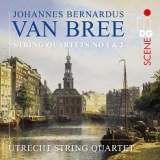Johannes Bernardus van Bree war stets gut gelaunt, großzügig und taktvoll, auch humorvoll. Das und sein auch autodidaktisch erworbenes musikalisches und organisatorisches Talent als Leiter von Orchestern und Chören in den Niederlanden brachten ihm reiche Anerkennung. Anfangs auch als Geiger aktiv, zog er sich bis aufs Wirken als Primarius in seinem Quartett vor allem auf das Dirigieren und Komponieren zurück.
Von seinen vier Streichquartetten liegen nun die ersten beiden vor. Das Erste von 1834 steht in der Tradition von Haydn. Soli der ersten Violine und des Cellos bestimmen den ersten Satz, aber alle vier Spieler leisten ihre Beiträge. Polyphonie prägt dann zunächst den zweiten Satz, bevor Cello und erste Violine wieder ihr Zwiegespräch halten. Das folgende Menuetto ist weniger auffällig. Den Schlusssatz mag man als Vertonung des optimistischen Charakters von van Bree hören, der ebenso sein handwerkliches Können unter Beweis stellt.
Das Zweite Streichquartett, 1840 veröffentlicht, ist Bernhard Molique gewidmet. Dieses Werk ist komplexer als sein Vorgänger, hier sind die vier Stimmen fast gleich gewichtet. Ungestüm führt ein Scherzo zum langsamen Satz. Das Stück endet lebhaft elegant und mit sorgfältiger Kontrapunkttechnik gesetzt. So geben sich beide Quartette charmant und zeigen die eigene gestalterische Note des Komponisten.
Das Utrecht String Quartet ist seit drei Jahrzehnten aktiv und hebt des Öfteren vergessene Werke. Dabei merkt man schnell, dass sie in van Brees Quartetten etwas entdeckt haben, dass sie mit Interesse und Hingabe vorführen. Sie schaffen eine gelungene Mischung aus analytischer Durchdringung wie auch höchst ausdrucksstarken Interpretationen, die aber auch der Musik nicht mehr aufbürden, als ihr gut tut. Im Zusammenspiel bestens eingerichtet, halten sie trotzdem die innere Spannung und Energie, um die vorgestellten Kompositionen in überzeugender Weise zu deuten.
Johannes Bernardus van Bree was always good-humored, generous and tactful, even humorous. This and his self-taught musical and organizational talent as director of orchestras and choirs in the Netherlands brought him great recognition. Initially also active as a violinist, he withdrew to conducting and composing, apart from being the first violin of his quartet.
The first two of his four string quartets have now been recorded. The first from 1834 is in the tradition of Haydn. Solos by the first violin and cello dominate the first movement, but all four players make their contributions. Polyphony then characterizes the second movement before the cello and first violin resume their dialogue. The following Menuetto is less striking. The final movement may be heard as a setting of the optimistic character of van Bree, who also demonstrates his craftsmanship.
The Second String Quartet, published in 1840, is dedicated to Bernhard Molique. This work is more complex than its predecessor, here the four parts are almost equally weighted. An impetuous scherzo leads to the slow movement. The piece ends in a lively, elegant manner and with careful counterpoint technique. Both quartets are charming and show the composer’s own creative touch.
The Utrecht String Quartet has been active for three decades and often performs forgotten works. You quickly realize that they have discovered something in van Bree’s quartets that they perform with interest and dedication. In doing so, they create a successful mixture of analytical penetration and highly expressive interpretations that do not burden the music with more than is good for it. Well-arranged in their interplay, they nevertheless maintain the inner tension and energy to interpret the compositions presented in a convincing manner.
























